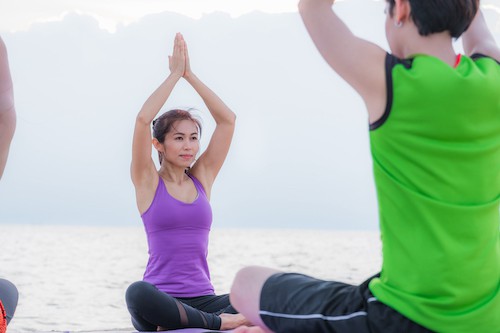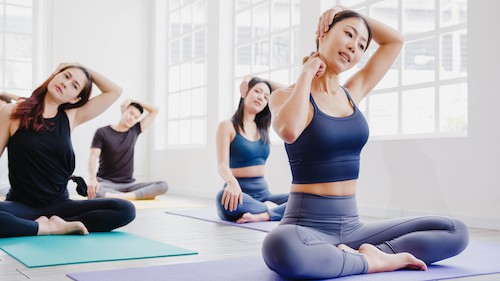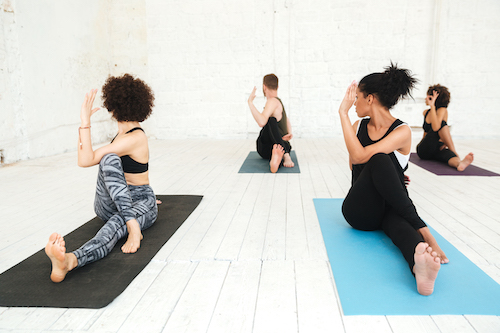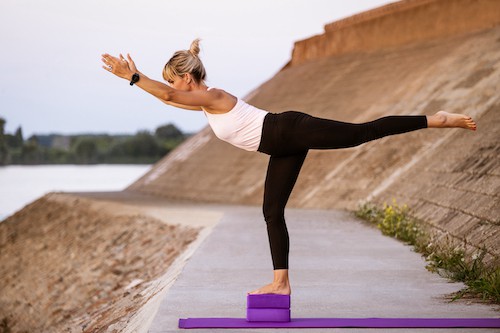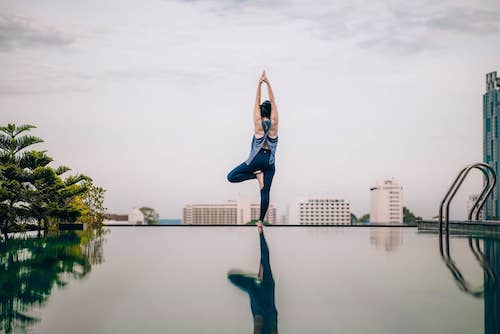Are you wondering what Ayurveda yoga is? Are you interested in learning about this exciting form of yoga? Dive into Breathing Deeply’s Ayurveda yoga guide!

From Kundalini to Power yoga to hot yoga, there are various forms and philosophies of yoga that can help with a variety of ailments and human conditions. Each of these kinds of yoga has its benefits, but not every style of yoga is right for everyone. Some may be looking for daily exercise, while others may require Ayurvedic yoga therapy, which can deeply attend to their individual goals and alleviate their suffering.
An example of yoga therapy that centers on the individual rather than a group is Ayurveda yoga. Incorporating Ayurveda into the healing process may be the key to lasting well-being, but what is Ayurvedic yoga, exactly?
I’m Brandt Passalacqua, the Co-founder, Director, and Lead Teacher at Breathing Deeply. I’ve spent decades practicing, sharing, and teaching Ayurvedic yoga. Keep reading to learn more about what ayurveda is, how it relates to yoga, the research on ayurveda yoga, the conditions it can treat, and how to get started either as a client of a yoga therapist like myself or train to become an Ayurvedic yoga therapist yourself.
Table of Contents:
- What Is Ayurveda?
- What Is Ayurveda Yoga?
- Does Ayurveda Yoga Work?
- What Conditions Can Ayurvedic Yoga Treat?
- Get Started with Ayurvedic Yoga Therapy
- Apply to Our Ayurvedic Yoga Therapy Training
What Is Ayurveda?
Ayurveda is a traditional Indian system of medicine that has been practiced for over 3,000 years. Its name comes from the Sanskrit words ayur (“life”) and veda (“science”/”knowledge”), or “knowledge of life.”
According to an Ayurvedic model, the universe and all its inhabitants, including humans, are composed of five elemental forces: ether (space), wind, fire, water, and earth. These five elements combine within the human body to form three key life forces, or doshas: vata, kapha, and pitta.
In the view of Ayurveda, the body and mind are interconnected, and the purpose of Ayurvedic practice is to bring about tridoshic balance. Everyone possesses a distinctive combination of doshas, typically with one or two being more prevalent, which dictates your personal health constitution. This means you may need to adopt certain changes in your diet, activities, or lifestyle to achieve greater doshic balance.
What Are the Three Doshas?
What are these three doshas in Ayurveda? They are vata, kapha, and pitta, and they correspond to your physiological, mental, and emotional health.
- Vata
- Elements: Space and Air
- Characteristics: Vata affects bodily movement, including breathing, blood flow, and bodily waste. It also affects the mind, enhancing communication, creativity, flexibility, and mental agility.
- Qualities: Dry, light, cold, rough, subtle, mobile, clear
- When In Balance: When vata is well-balanced, it promotes creativity and flexibility.
- When Out of Balance: When vata is out of balance, it can encourage fear and anxiety.
- Kapha
- Elements: Earth and Water
- Characteristics: Kapha helps to emphasize structure and solidity. As a water-based dosha, it helps to hold the body together and encourage its growth. It’s also important for immune health.
- Qualities: Heavy, slow, steady, solid, cold, soft, oily
- When In Balance: When kapha is properly balanced, it’s easier to love and forgive others or yourself.
- When Out of Balance: When kapha is not carefully balanced, it can encourage jealousy, insecurity, and even weight gain.
- Pitta
- Elements: Fire and Water
- Characteristics: Regarding the body, pitta influences your metabolic systems, including digestion, absorption, nutrition, and body temperature. Mentally, it encourages intelligence and understanding.
- Qualities: Hot, sharp, light, liquid, mobile, oily
- When In Balance: When pitta is in balance, it can enhance your intelligence and promote feelings of contentment.
- When Out of Balance: When pitta is out of balance, it can contribute to ulcers in the body, as well as feelings of anger or jealousy.
When the three doshas are in balance, congratulations! You’re in good health, both mentally and physically. However, when your doshas are imbalanced, disease and unhappiness can take root in your life.
Ayurveda yoga, in particular, aims to assist with this balancing of your doshas with a customized program of special postures, meditation, and breathing exercises.
What Is Ayurveda Yoga?

So exactly what is ayurveda yoga, or ayurvedic yoga? Ayurveda is considered the sister science to yoga. According to some views, Ayurveda provides you access to the diagnosis of your ills, while yoga provides the cure.
Yoga exercises help mindfully connect you with your body. Ayurveda encompasses more than just exercises, though; in practice, it represents an entire philosophy of life and living.
When you get right down to it, Ayurveda and yoga are really two sides of the same coin. And Ayurveda yoga, in particular, represents the great intersection of these two ancient sciences of life. In short, Ayurveda yoga practitioners have access to diagnosis and cure in one package, promoting a more holistic approach to your well-being.
How Does Ayurvedic Yoga Work?
More popularized forms of yoga offer a one-size-fits-all approach to wellness. You’re in a room with others, and everyone does the same exercises at the same time. But, since every human being is different, Ayurvedic yoga offers a more specialized practice of yoga. It’s based on your own needs, tailored to correcting your own individual imbalances.
Remember the meaning of “Ayurveda?” It’s “knowledge of life.” As for “yoga,” that comes from the Sanskrit root word yuj, meaning “to join” or “to unite.” Ayurveda yoga is, thus, the holistic union of the knowledge of life and the practices of yoga.
Because Ayurvedic yoga must be personalized by its very nature, it resists the typical group yoga class structure. It requires an experienced practitioner to sit down with a client, assess their doshas, and determine an appropriate treatment. This would include holistic changes to your lifestyle, for example:
- Going outside every morning
- Performing breathing exercises at a particular time
- Eating your biggest meal around noon
- Yoga poses to practice on a regular basis
- When to go to bed
To achieve this kind of individualized care, especially if you want to address a particular health concern, you should seek the help of a yoga therapist.
What Is Ayurvedic Yoga Therapy?

A yoga therapist works one-on-one with a client, using yoga techniques to address specific physical, mental, emotional, or spiritual health issues. An Ayurvedic yoga therapist uses their knowledge of the three doshas to guide clients through yoga practices that fit their clients’ unique physiologies and characteristics.
For instance, what works for someone with a vata imbalance will not work for someone of a pitta nature or a kapha imbalance. Great care must be taken in the approach to dosha-specific asana (movement) and pranayama (breathing) practices.
There are many benefits to ayurvedic yoga therapy, but these are a few of the major ones to keep in mind:
- It’s personalized: Yoga therapy isn’t a one-size-fits-all package. The element of personalization comes from the Ayurveda yoga therapy assessment. To truly personalize yoga therapy, it should not only take any specific health conditions into consideration, but also the person’s unique circumstances and doshic balance.
- It’s holistic: Ayurveda yoga involves more than just practicing a set of yoga poses. It can help you change your life holistically to better balance your doshas and achieve overall well-being, involving how you move, exercise, breathe, eat, sleep, and schedule your day. Western medicine tends to look at each condition a person has separately. Ayurvedic yoga therapy looks at them all together, giving you a better picture of what’s happening and how to address it.
- It evolves: As you continue to go to yoga therapy sessions, your yoga therapist can assess how your mind and body are responding to treatment. If you notice any other symptoms or issues, these can be taken into account as well. If you need to make further adjustments to the yoga techniques you practice or your lifestyle, these can evolve to meet your needs.
- It empowers: You don’t need to see a yoga therapist indefinitely. Our job is to properly assess your needs, work through techniques with you, and get you to a place where you can continue with the Ayurvedic yoga practices and lifestyle changes we’ve recommended on your own. This empowers you to have more control over your health and well-being.
Does Ayurveda Yoga Work?
On the whole, Ayurveda yoga can help restore balance and provide great relief for those dealing with many issues. Ayurvedic yoga therapy is a mind-body-spirit approach that can aid in getting in touch with, rather than suppressing, your emotions. Ayurveda offers a path to a happier, healthier, and more physically fit life.
Here are just a few of the scientific findings on Ayurveda and yoga:
- A 2023 literature review from the University of Maryland School of Nursing found multiple studies that indicate yoga techniques, particularly pranayama (breathing exercises), can effectively lower blood pressure for those with hypertension. The author concludes that Ayurvedic yoga can be beneficial as a non-pharmaceutical treatment for hypertension.
- A 2022 literature review published in the Journal of Ayurveda and Integrative Medicine found that there is evidence to suggest that yoga and Ayurveda can affect the immune system to prevent or reduce infection, as well as improve respiration and mental health. In particular, there is potential for yoga and Ayurveda to help prevent COVID-19 infections and, for those who are infected, to help ease their symptoms, reduce their infection, and improve lung function, mental health, and quality of life.
- In a 2019 study from the Journal of Alternative and Complementary Medicine, researchers came to the following conclusion: “A whole-systems Ayurvedic medicine and Yoga therapy approach provides a feasible promising noninvasive low-cost alternative to traditional weight loss interventions with potential added benefits associated with sustainable holistic lifestyle modification and positive psychosocial changes.”
- A 2019 research article published in the Academic Consortium for Integrative Medicine & Health found that health and wellness courses that use Ayurveda, with its mind-body-spirit emphasis, can improve well-being in a variety of ways both during and after the course.
As the public becomes more aware of Ayurvedic yoga, I expect to see more studies conducted on it and more evidence of its efficacy.
What Conditions Can Ayurvedic Yoga Treat?
What other conditions or ailments might really benefit from Ayurveda yoga? As an approach that addresses physical, mental, emotional, and spiritual well-being, Ayurvedic yoga can help with a wide range of conditions.
In my experience, mental health tends to be where Ayurvedic yoga really shines, due to its intrinsically individualized nature. But it can help promote healing for a huge variety of conditions, such as:
- Anxiety
- Depression
- Trauma
- PTSD
- Addiction
- Insomnia
- Eczema
- Chronic conditions
- Autoimmune diseases
- Cancer support
- And many more!
Get Started with Ayurvedic Yoga Therapy

If you’re looking to holistically improve your health and well-being, consider our Ayurvedic yoga therapy. Led by myself and a hand-picked group of certified yoga therapists, you’ll receive individualized care online over Zoom. Learn more and fill out a form today to see how we can help.
Apply to Our Ayurvedic Yoga Therapy Training
If you want to become a yoga therapist yourself using an Ayurvedic yoga approach, apply to Breathing Deeply. Whether you have already studied yoga as a yoga teacher or not, we have a path for you to become a qualified yoga therapist online under my direction with our Ayurvedic yoga therapy training. Learn more and apply today to start your journey to help others heal.

